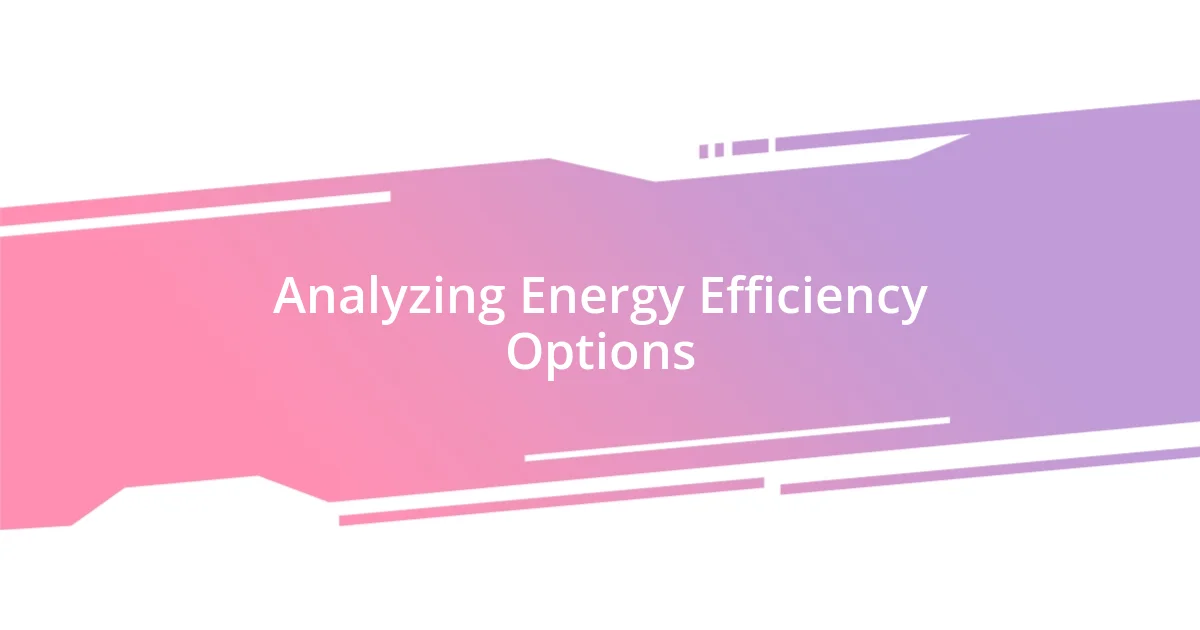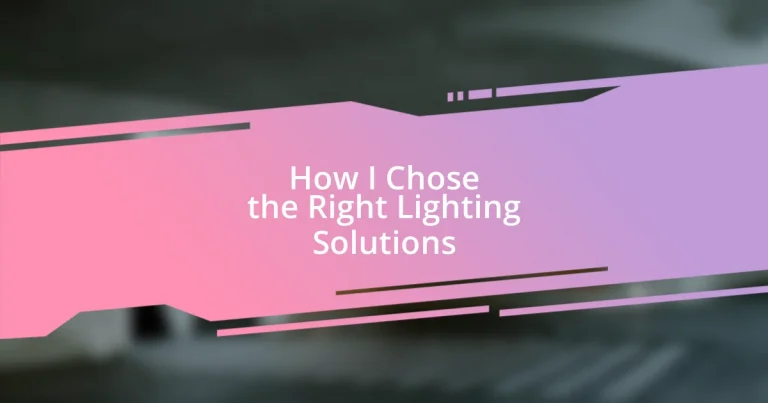Key takeaways:
- Evaluate your lighting needs by assessing space functionality, desired mood, and aesthetics to enhance comfort and productivity.
- Choose energy-efficient lighting options like LED and smart lighting, which can lower electricity bills and provide adjustable features for better ambiance.
- Create a budget for lighting to prioritize expenses and take advantage of sales, ensuring informed choices without compromising quality or style.

Understanding Your Lighting Needs
Understanding your lighting needs begins with evaluating the spaces you typically use. I remember when I first moved into my apartment; the living room felt so dull and lifeless. I realized that bright overhead lighting didn’t suit my cozy vibe, and that’s when I started pondering, how do I make this space feel warm and inviting?
Next, consider the activities you’ll be doing in each area. For instance, in my home office, I once relied solely on a low-wattage lamp, thinking it would create a calming atmosphere. Instead, I often found myself straining to see the screen. It hit me that appropriate lighting isn’t just about aesthetics; it’s essential for productivity and comfort, too.
Finally, think about the mood you wish to create in your space. I’ve experimented with different light colors and found that softer, warmer lights evoke a sense of tranquility. Does your space need energy, or a peaceful retreat? Identifying the desired ambiance can tremendously influence your choice in lighting solutions, ensuring they align with your lifestyle and emotional well-being.

Evaluating Different Lighting Types
When evaluating different lighting types, I often consider how each type will interact with the space and its purpose. For example, I used to have a halogen lamp in my kitchen, which produced a harsh, unnatural light that made cooking feel like a chore rather than a joy. Switching to LED recessed lighting not only brightened the room but also transformed meal prep into a more enjoyable experience, enabling me to appreciate the colors and textures of the ingredients.
Here’s a quick breakdown of common lighting types and their characteristics:
- Incandescent Lights: Warm and inviting, but energy-inefficient.
- LED Lights: Long-lasting and energy-efficient; versatile color temperatures available.
- Fluorescent Lights: Bright and cost-effective; often found in workspaces but can be harsh.
- Halogen Lights: Bright, white light; good for task lighting but can get hot.
- Smart Lighting: Adjustable brightness and color; adds convenience and can create specific moods.
Taking the time to evaluate these options helped me tailor my lighting choices to meet my needs and enhance my living environment seamlessly.

Analyzing Energy Efficiency Options
When delving into energy efficiency options, it’s crucial to compare not just costs but also the long-term benefits of each type of lighting. I recall replacing my old fluorescent lights with LEDs – it wasn’t just about saving money initially, it was the reduction in energy use over time that really impressed me. I was pleasantly surprised to see a notable dip in my electricity bill after making the switch, creating a sense of empowerment in my environmentally-conscious efforts.
Understanding lumens and watts can also shift your perspective on energy efficiency. Initially, I focused solely on wattage, assuming lower numbers meant less brightness. But lumens— which measure brightness—gave me a clearer picture. A 10-watt LED bulb produces around 800 lumens, which is about the same as a 60-watt incandescent bulb but with drastically less energy consumption. This newfound knowledge helped me select lights that were both efficient and bright, ultimately enhancing the ambiance in my home without the guilt of energy waste.
Finally, consider how smart lighting technology can elevate energy efficiency. I once invested in smart bulbs, not just for convenience but because of their ability to adjust based on my daily schedule. Programmed to dim when I’m not in a room, these bulbs literally save energy, resulting in that euphoric feeling of doing my part for the planet. It’s rewarding to know that small choices in lighting can contribute to a significant positive impact on energy consumption over time.
| Lighting Type | Energy Efficiency Rating |
|---|---|
| Incandescent | Low |
| LED | High |
| Fluorescent | Moderate |
| Halogen | Moderate |
| Smart Lighting | Very High |

Considering the Aesthetic Impact
When I think about aesthetic impact, I can’t help but recall a recent project in my living room. I swapped my old pendant light for a contemporary chandelier, and the difference was shocking. Suddenly, the space felt larger and more inviting, showcasing my decor in a whole new light. It’s amazing how one choice can redefine the atmosphere of a room; have you ever had a similar experience?
In my bedroom, I opted for soft, warm LED string lights along the headboard. The cozy glow made the room feel like a sanctuary, perfect for winding down after a long day. I often find myself just staring at them, basking in the serenity they provide. Isn’t it interesting how lighting can evoke such strong emotions and set the mood for our most personal spaces?
When selecting artwork or decor, I always consider how the lighting will highlight them. For instance, I installed adjustable spotlights to accentuate a large painting on my wall. The way the light catches the textures brings the piece to life in ways I had never anticipated. It got me thinking—how often do we underestimate the power of lighting in showcasing what we cherish most?

Exploring Smart Lighting Solutions
Exploring smart lighting solutions has truly transformed my approach to home illumination. When I first experimented with voice-activated smart bulbs, I was amazed at the convenience they offered. Imagine being able to dim the lights or change their color simply by asking—it’s like something out of a sci-fi movie! I remember one night, I wanted a cozy atmosphere for a movie marathon, and all I had to do was say, “Set the lights to warm white.” It made the experience feel so special, all with just a few words.
The ability to control lighting from my phone was another eye-opener. One day, I forgot to turn off the lights when I left for work and felt a pang of guilt. Luckily, I could easily switch them off remotely. This not only saved energy but also brought me peace of mind. Have you ever forgotten to turn things off and wished for an easier solution? After this encounter, I realized that smart lighting is not just about luxury; it’s about practicality and sustainability.
Additionally, I’ve loved integrating smart lighting into my daily routine. I set schedules for my lights to mimic natural daylight—soft brightness in the morning and a more subdued glow in the evening. This gradual transition has significantly improved my mood and energy levels throughout the day. Have you ever noticed how harsh lighting can affect your peace of mind? Embracing these solutions has not only enhanced my living space but also created an ambiance that nurtures my well-being.

Setting a Budget for Lighting
Setting a budget for lighting can feel overwhelming at first. I remember sitting down with a notepad, trying to figure out how much I wanted to spend on my living room transformation. I quickly realized that setting a clear budget is crucial; it allows for prioritization and helps in making informed choices. Have you ever found yourself wondering where to start?
In my experience, breaking down costs into categories can simplify the process. For instance, I allocated a portion of my budget for fixtures, another for installation, and set aside some funds for bulbs. This way, I felt more in control and could adjust each category as necessary. I have to say, seeing my budget line up with my vision made me feel excited rather than restricted. Doesn’t it feel good to know exactly where each dollar is going?
As I refined my budget, I also kept an eye on seasonal sales and promotions. One time, I stumbled upon a flash sale on pendant lights, which allowed me to snag a beautiful piece at a fraction of the price. It’s moments like these that make the effort of planning worth it. Planning to save a few bucks can add up significantly without sacrificing quality or style. Have you explored similar opportunities in your lighting journey?

Making the Final Selection
Making the final selection of lighting solutions is often the most exciting yet daunting part of the process. I remember standing in a store surrounded by an array of fixtures, each promising something unique. It’s crucial to visualize how each piece will fit into your space. Have you ever stared at a lamp thinking, “Does this really match my vibe?” My heart raced when I found a stunning chandelier but hesitated because I wasn’t sure if it would overwhelm my living room.
One technique that really helped me was creating a mood board. I gathered images of my favorite lighting styles and arranged them alongside pictures of my room’s decor. This exercise made me realize the importance of cohesion. I often found myself asking, “How does this lighting reflect the mood I want?” It became easier to dismiss options that didn’t resonate with my vision, saving me time and energy, and allowing me to unleash my creativity.
After much deliberation, I took a leap of faith and went with a modern pendant light that had an industrial feel. It was a risk, but I trusted my instincts. The moment it was installed, I felt a rush of joy. The ambiance transformed! I often think about the journey of choosing that light and how it taught me the value of trusting my gut. Have you experienced a moment where the perfect choice came out of a mix of careful research and pure intuition?














